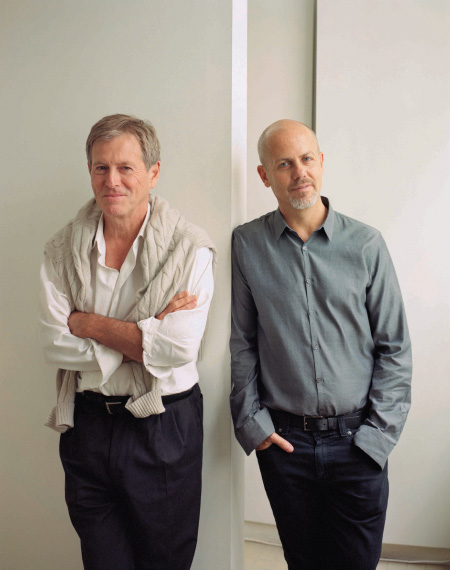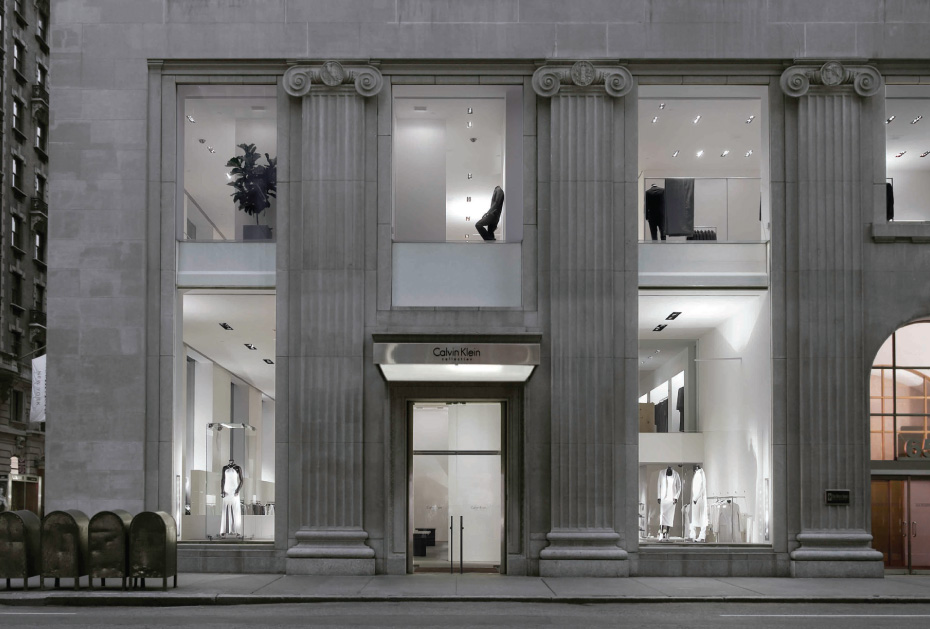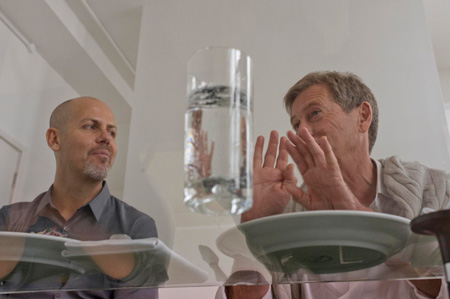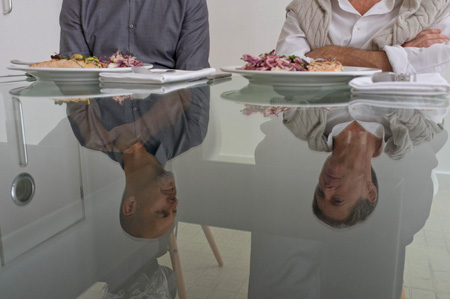What happens when you bring two prize winning visionaries together? Designers Italo Zucchelli and John Pawson met Port for lunch to discuss their inspiration, their approach to work, and to explain how the principles of fashion and architecture aren’t really that different after all
At first, there appear to be few similarities between Italo Zucchelli and John Pawson. Italo, the creative director of Calvin Klein Collections menswear turns up bang on time for our lunch date. He introduces himself with calm precision in a bold, confident voice, and is dressed with stylish insouciance, wearing a dark grey shirt with unfastened cuffs, black jeans and trainers. One of the world’s most revered practitioners of minimalist architecture, John arrives 30 minutes later, having been held up at yet another meeting about the former Commonwealth Institute, a Grade II-listed building in Kensington and Chelsea that he plans to re-launch as the new home for the Design Museum in 2014. Dressed smart-casual in a white shirt, sleeves rolled up to the elbows, with a cream jumper draped over his shoulders, black trousers and smart black shoes, he is soft-spoken and somewhat distracted. But despite superficial differences, there is more in common between these two men than meets the eye.
Photography Eva Vermandel

Kat Phan: As a child, when people asked you what you wanted to be when you were older, what was your answer?
Italo Zucchelli: Probably a rock star – something connected to music and performing for sure.
John Pawson: I still want to be a rock star! I can’t really remember beyond the obvious things but I think I might have wanted to own a record shop or a shop where I could control everything. I had my own ideas about how people would come in from the street, and how they would interact. My family had a business making women’s clothes in Yorkshire, which my father wanted me to work for. I think he would have liked to have been an architect, but throughout my younger years, he discouraged me from being one.
Kat: Why do you think that was?
John: Well, my father thought you could employ them because it’s a profession – and if you can employ somebody, why would you do it yourself? Of course for me that was missing the point. And then at school, they said we had to do maths, which isn’t quite true. It wasn’t until I was 30 that I went to architecture school.
“Steve Jobs said that the best design in life
is that you die – because it means renewal,
that there is a cycle”

Kat: If you had more hours in the day, what would you be doing with them?
John: Sleeping.
Italo: I think that the day is perfect with 24 hours. It’s enough for me. I don’t wish I had more and if I did – as John said, I would just sleep.
John: Steve Jobs said that the best design in life is that you die – because it means renewal, that there is a cycle. It’s the equinox next week – 12 hours of daylight and 12 hours of darkness. I like getting up at dawn because I always feel like I’ve got a bit more time… But then I’m too tired in the evening to do anything!
Kat: What kind of character flaws do you think have served you well in your work and in your personal lives?
John: Well I know Italo is perfect…
Italo: Yes, right! I think I can be a little stubborn at times. But let’s say, for example, you want to achieve something and you come up against obstacles – it can help to be stubborn, to persevere. When you find that you do achieve it through being that bit stubborn, it can be very rewarding.
John: I am a perfectionist; I love perfection. Of course I am not perfect – I have lots and lots of faults, but that’s probably why I like to try and achieve it. I get upset about small things but big things I don’t because – what can you do?
Kat: How would you describe your signature style?
Italo: It’s important to me that something will be just as valuable today as it will be in 20 years’ time – or even longer. There has to be a purity and a timelessness to it; a cleverness that is never going to go out of style or out of date.
John: Mine’s the same. Exactly the same. Also, in architecture, it’s important to be able to see the space. That’s why you clear it. You’re not creating a minimalist environment for the sake of it – clarity gives it reason.
Kat: What do you define as being good design?
Italo: It’s about being functional. To design clothes for men – especially for men – you cannot put, for example, a nicely designed pocket somewhere they’re not going to use it. I need to make clothes in a way where they are fashionable and functional. And as I said before, there also has to be an element of timelessness about it.
John: I think you’re right; it’s not good design if it isn’t functional. I try to explain this to clients when they ask for strange things, that it’s a piece of architecture and it’s going to be around long after they have gone. You can’t try and experiment too much – it’s a building. You design around how people live; I don’t design things and then expect people to live by those rules. I find out what they want and build something that reflects how they live.
Kat: What do you think are the basic principles that fashion and architecture share?
Italo: Well they both involve proportions, shape and materials, which are underpinned by creativity. I guess there are similar sources of inspiration in both fields as we are working with colours, textures and proportions – although, of course, fundamentally there are differences as in one case we are talking about these principles in relation to the body and in the other, in relation to space.
John: We’re both building things around the way people live and move – the human form is our point of focus. I think I learned a lot about material from my father’s business, which has made a difference in how I approach my work. There’s certainly an overlap in the concepts used in the composition and texture of patterns.
Kat: What do you think the greatest challenges are in designing today in comparison to 20 years ago?
Italo: In 20 years of fashion, a lot has been done. Now there are a thousand brands and a thousand designers so the challenge is about keeping things fresh, finding new things and creating new concepts in a world that is already saturated with ideas.
John: When you’re designing, you start with a clean sheet of paper and are very, very open. Then you start applying restrictions. If you’re on the internet, you can see everything around the world that’s being done, and I think that can be rather daunting – you have to work from within yourself.

I don’t worry about my work being similar to somebody else’s: the more you work on it, the more original and personal it becomes. It’s always going to look like somebody else’s. If you sat down with likeminded people with a certain level of intelligence and you’re looking at something you’ve both never seen before, you’re likely to come up with the same solutions. It’s the joke in the office that somebody can always find something that looks very similar.
Kat: How do you think the design market in both your respective industries has changed over the years?
Italo: Fashion has gone through periods of hyper-design, like in the 80s when it was over-designed. I think there are more challenges now because there’s so much more variety. This makes it a little harder to have an identity. There are a lot of fashionable clothes that are available at every level of the market; the challenge, depending on the brand and the level of your position, is to keep it real, to keep it desirable by keeping it wearable.
John: For me it’s when people say I want the space, but I don’t want to spend the money. There is some leeway but there’s a minimum cost for production depending on where you are. In the end you have to build in wood, or concrete or steel. If you are in the business of creating space then the materials matter, but you don’t have to use stone.
Kat: Is there a particular century that you would have liked to design for?
Italo: I would say the Renaissance, but not as a fashion designer – I would have been a painter. That was a period of amazing creativity – and a lot of competition too, but I imagine that it was a very interesting and exciting time. I wouldn’t say any other time in this century – maybe it’s too close to where we are now.
John: I’m very happy with the present! I don’t want to go back; I don’t really want to go forward. It’s a great time. The population, the amount of people on the planet and the resources – there are going to be big changes.
Italo: I believe we are on the brink of a new interesting time where we’re going to have to come up with a lot of creative solutions to the way we work, the way we design, the way we move to life. I’m with John – it’s a great time now.
Kat: What things excite you about the future of design?
Italo: I read last week that the most sought-after jobs of 2010 didn’t even exist in 2004. So if we continue at this pace, we’ll be looking at more of these jobs in 2020. That’s what exciting about this time of evolution – there’s a lot of stuff we aren’t aware of yet that are going to be in place very soon. We have to be very flexible and open to change.

Kat: Do you think it’s more difficult to stay flexible as you get older?
John: When I say my son is in the music business, people respond, “Oh it’s very, very difficult, the music business.” But he’s never known anything different – he makes it work, he makes money and he enjoys it. He just does what he thinks.
Kat: He manages The xx doesn’t he?
John: Yes, they met at one of their early gigs. Caius is a bit older than them and he’s like the big brother. He did it instinctively – he didn’t know what they’d become, he was interested in what they were doing and wanted to help. It’s funny because we often had Adele and Florence around at our house – we just thought of them as young friends of Caius. They’re huge now!
Italo: John is right in the sense that because his son doesn’t know any other way, he is more likely to come up with more creative and possibly more effective solutions than somebody who has been in the industry for many years. That’s why I said – going back to your original question – we’re going to have to be very flexible and open to the way we do things because it’s going to change a lot.
Kat: What sort of things are you inspired by?
Italo: I’m very inspired by music. I mainly like music that is quite simple – kind of still, electronic and modern but evocative. That’s why I like The xx; in their own way they’re quite simple and the sphere of their music is certainly evocative. Also, there’s the usual other stuff, like books and movies. I’m a very visual person – I always have been since I was 15.
John: Anything of quality; I think people are always surprised if I like anything baroque. They say to me, “Oh you wouldn’t like my house, I’d be so embarrassed to invite you because it’s not… ” I mean, it’s like… what? Why would I be…? I’ve been doing a book for Phaidon of my snapshots, so I take photographs everyday like a visual notebook and I think they were expecting Agnes Martin, lines, Japanese… but they’re very, very different.
Italo: Sometimes even if the end result is simple, behind that is a very complicated thought process, creative process, references that go in and come out in very simple ways, it’s very true.
John: I think people who say they’re inspired by one thing or you know, when you go to lectures in architecture, you often hear the architect say he was inspired by the curves of a woman’s body and I’m like . Do you know what I mean? It’s how you see that is different – we all see things differently. It’s not what you’re looking at, it’s how you see.
Kat: How will you be spending the rest of the year?
Italo: I am launching a new collection in January in Milan so I still have a lot of work to do for that, but I will take some time off for Christmas. I think it is very important in life to create time for yourself and to really enjoy it, because this is when you open your mind to get inspired.
John: Agnes Martin said you should avoid unnecessary friends. She’s written a book called Thoughts – it’s brilliant stuff. You have to open your mind by being alone. I was brought up in Yorkshire and it took 30 years to get to London, so I was always outside in the countryside. I had a lot of time on my own. You could call it boring time, but the great thing about it is that it is your time to think.
Italo: The best time for me to think is when I am on the beach and nobody is there. In this sense we are hardcore minimalists!
John: I have this thing where, if I say to myself, “If I work really hard today, or this week then I have the rest of the time off.” I have nothing in my diary beyond next week. I’ve got all of these plans to go away to the desert. The trouble is that my wife has suddenly become very busy, so I might just sit home with an empty mind.
This interview originally appears in Port issue 4




